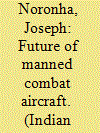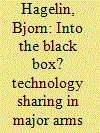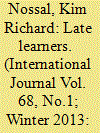| Srl | Item |
| 1 |
ID:
130495


|
|
|
| 2 |
ID:
102227


|
|
|
| 3 |
ID:
099556


|
|
|
| 4 |
ID:
071057


|
|
|
| 5 |
ID:
119373


|
|
|
| 6 |
ID:
113114


|
|
|
|
|
| Publication |
2012.
|
| Summary/Abstract |
From the recipients' perspective, arms transfers have, through the use of offsets, technology transfers, and industrial participation, become an opportunity to receive not only advanced weapons, but also technologies not otherwise available. How important are friendly relations for securing a military export order? To what extent do buyers demand advanced military or commercial technology and how are these demands accepted by the supplier? How does this influence smaller producers in relation to major producers? These questions are addressed by studying (a) the Joint Strike Fighter/F-35 by Lockheed Martin, USA, and the JAS-39 Gripen aircraft by Saab, Sweden, (b) the Medium Multi-Role Combat Aircraft competition in India for 126 combat aircraft, and (c) the Indian offset policy. In the final section, some long-term consequences are discussed.
|
|
|
|
|
|
|
|
|
|
|
|
|
|
|
|
| 7 |
ID:
121248


|
|
|
|
|
| Publication |
2013.
|
| Summary/Abstract |
Looking at the process that the Conservative government of Stephen Harper
tried to use to replace the Royal Canadian Air Force's aging CF-18 Hornet fleet
with 65 Lockheed Martin F-35 Lightning II Joint Strike Fighters, it is hard
to disagree with Andrew Coyne's assessment that the acquisition program
was "a fiasco from top to bottom, combining lapses of professional ethics,
ministerial responsibility and democratic accountability into one spectacular
illustration of how completely our system of government has gone to hell."1
For the evolution of Canada's participation in the F-35 program-from
the first memorandum of understanding (MOU) signed by the Liberal
government of Jean Chrétien on 2 January 1998 to the so-called "reset" of
the program in December 2012-readily fits the nouns the Canadian media
so commonly used to characterize the F-35 acquisition: fiasco, debacle, mess,
scandal, and shambles in English, or fiasco, scandale, incompétence, gâchis
(mess), gouffre financier ("money pit") in French.
|
|
|
|
|
|
|
|
|
|
|
|
|
|
|
|
| 8 |
ID:
157986


|
|
|
|
|
| Summary/Abstract |
Why does joint defence production of advanced weapons systems, which appears like a logical choice at first, become harder for both the primary production state and its allies to manage and justify as the acquisition process runs its course? To answer this question, we analyze the multinational politics of the F-35 JSF with a focus on how secondary states who have bought into the program are affected by domestic politics within the primary production state. We find that US congressional and bureaucratic politics, cuts to US defence spending, and a desire to retain tight control over the program has locked allies into a program with which they have little leverage. Potentially losing the ability to fight along side the US if they don’t follow through, coupled with inter-Alliance pressures, leaves secondary states who are involved with the F-35 program, vulnerable to the whims of US domestic politics.
|
|
|
|
|
|
|
|
|
|
|
|
|
|
|
|
| 9 |
ID:
146489


|
|
|
|
|
| Summary/Abstract |
How did the Canadian news media cover the F-35 Joint Strike Fighter purchase, proposed by the Harper government in mid-2010? Under what conditions did the media tend to index government talking points as opposed to providing space to oppositional voices and viewpoints? Content analysis of headlines and full text transcripts in five mainstream newspapers revealed news coverage that was mostly negative and that it became more negative as consensus within official decision circles dissipated. Overall, the findings fit most closely with the predictions of the cascading activation model of government–media relations, while also underscoring the importance of factors specific to the Canadian context.
|
|
|
|
|
|
|
|
|
|
|
|
|
|
|
|